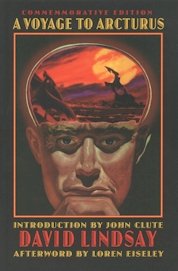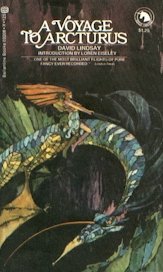
A strange, metaphysical journey
University of Nebraska Press 2002
Commemorative Edition
268 pages (left)
Ballantine Books Adult Fantasy 1968
287 pages (right)

Denver Science Fiction & Fantasy Book Club |
 |
A Voyage to Arcturus (1920) A strange, metaphysical journey University of Nebraska Press 2002 Commemorative Edition 268 pages (left) Ballantine Books Adult Fantasy 1968 287 pages (right) |
 |
|
Our book ratings Review #1- Aaron's Commentary |
Review #2 - Amy's Commentary David Lindsay bibliography |
| Dan | 2 | Amy | 4 |
 |
10 Wow! Don't miss it 8-9 Highly recommended 7 Recommended 5-6 Mild recommendation 3-4 Take your chances 1-2 Below average; skip it 0 Get out the flamethrower! U Unfinishable or unreadable - Skipped or no rating given |
| Cheri | 7 | Barb | - | ||
| Aaron | 8 | Cynthia | 1 | ||
| Jackie | - | Ron | 3 | ||
| Caren | 1 |
Review #1:
Aaron's Commentary
David Lindsay - A Voyage to Arcturus
"To see beauty in its terrible purity, you must tear away the pleasure from it." The fantasy genre has a fascinating history, because there are several points where the entire field could have gone in a sharply different direction. Weird Tales might have dominated the field of fantastic fiction for decades if its editor and two best writers (Farnsworth Wright, H.P. Lovecraft, and Robert E. Howard) had not all died prematurely between 1936 and 1940. If John W. Campbell had chosen to drop Astounding magazine in favor of his fantasy magazine Unknown, instead of the reverse, the period from the late 1930's to the early 1950's might now be called "the Golden Age of Fantasy." And consider how the fantasy genre was reshaped by the phenomenal attention Lord of the Rings received in the 1960's, so that the entire field quickly came to be dominated by "high fantasy," nearly always with a medieval setting and featuring hardened warriors, mysterious sorcerers, and a collection of elves, dwarves, and other magical creatures. For many years, the prevalence of "high fantasy" left little room for other forms of fantastic fiction, and many readers have forgotten that there was actually more breadth to the genre before Tolkien came along. A Voyage to Arcturus, published in 1920, is an entirely different kind of fantasy, also sophisticated, written for an adult audience, also filled with the wondrous and the bizarre, but without a battle, sorcerer or elf in sight. (Since the story begins with a journey on a spaceship to another planet, one could try to call this science fiction, but the narrative is far too surreal and mystical for that label to apply comfortably.) Like Lord of the Rings, A Voyage to Arcturus is deeply concerned with basic moral issues such as the struggle between good and evil, but on a much more subtle level. The struggle doesn't turn on how good can defeat evil, but on what good and evil are and how one can distinguish them. In the way it handles such issues, A Voyage to Arcturus makes for an interesting case study in the difference between symbolism and allegory. The various beings Maskull encounters each seem to represent a particular philosophy or way of seeing the world. On the one hand, this feels like symbolism rather than outright allegory, because Lindsay is not heavy-handed about who represents what, or about which philosophies he approves or disapproves of. It is not always clear how a particular character or event fits into the overall pattern, just as one can never quite be sure what the characters' evocative names convey. On the other hand, it is like allegory in that the symbolism itself drives the novel. There is no coherent story line. Maskull goes from place to place, with no particular reason to go to any of those places, other than to give David Lindsay the opportunity to make whatever symbolic point he wants to make next. This is a dangerous way to write a novel. Without a strong enough thread to the story to pull us along, Lindsay is counting on engaging his readers with his symbolic points. Yet the symbolic meanings of characters and events are usually deliberately unclear. I can't fault readers, including most of the members of our group, who get exasperated with the whole thing. Thankfully, there are some occasions when Lindsay's symbolism starts to come clear, for example after Corpang explains the three "worlds," founded on existence/life, relations/love, and feeling/worship. These three dimensions of being directly track the second half of Maskull's journey, through Matterplay, Lichstorm, and onto the Ocean. As a symbolic explanation of the Trinity, this comes as close as anything ever has to giving that concept meaning for me. What's more, much to my own surprise, I enjoyed reading this book just as well during passages in which the symbolism was hopelessly obscure. For me the novel's saving grace is that the setting is very interesting, even stripped of any symbolic meaning, simply for its utter strangeness. In fact, while I was reading this, I came to believe that the awkwardness of the story was a deliberate part of the strangeness, rather than reflecting ineptness by Lindsay. The first example was right at the beginning of the book, when we are introduced to a host of characters at a sťance who are carefully described, but then disappear entirely from the story. Meanwhile, two fellows who arrived late for the sťance, and about whom we are told absolutely nothing, turn out to be crucial characters, one of them the protagonist. Is this clumsy? Or is this a device to convey the strangeness of these two characters? The protagonist Maskull seems to have things hidden in his past, things of which he is himself unaware consciously, yet he never stops to examine the gaps in his own memory. It's as if he is a character in a novel stripped of any personal background. Hmm. At many points in the narrative, people do strange things for no apparent reason. Did Lindsay fail to adequately explain their motivations? Or did he insert all these peculiar actions to generate a dreamlike quality to the story? Certainly it has that. All of the characters Maskull encounters are wonderfully enigmatic. They are also often strangely menacing, for Lindsay had a knack for creating a sense of dread using understated language. His description of the strong absorbing the souls of the weak, for instance, is an effective metaphor for evil - the desire to dominate others - and, more to the point, is a vivid and memorable image, more frightening than nearly anything modern-day splatterpunks can come up with. I am most impressed that Lindsay could write something that still feels so genuinely weird eighty years later. Some of the language he employs to that effect is astonishing in hindsight: The daylight disappeared at the first bend in the tunnel. After that, Maskull could not say where the light came from. The air itself must have been luminous, for though it was as light as full moon on Earth, neither he nor Leehallfae cast a shadow. Another peculiarity of the light was that both the walls of the tunnel and their own bodies appeared colorless. Everything was black and white, like a lunar landscape. This intensified the solemn, funereal feelings created by the atmosphere. To say that light was generated by the air itself is a nice enough image. But to have thought in 1920 to describe something as "black and white, like a lunar landscape" is incredible. Lindsay's fantastic realm is never really convincing - not at all comparable to Tolkien's carefully constructed Middle Earth, for example - but it is so vividly conceived and so fundamentally strange even eighty years later that it nonetheless still has real power. WARNING: If you have the 2002 Bison Books edition of A Voyage to Arcturus (the one with "Commemorative Edition" misspelled on the cover) DO NOT READ THE INTRODUCTION by John Clute until after you finish the novel. Not only is it riddled with spoilers, it will unforgivably prejudice your interpretation of the book. You can read Loren Eiseley's note (the Introduction to the Ballantine edition, the Afterword to the Bison edition) whenever you like, but be sure to spit on it when you do. What do you think? Your comments are welcome. Please send them to vanaaron@excite.com |
|
Review #2:
Amy's Commentary
David Lindsay - A Voyage to Arcturus
I generally write book summaries, but I don't think I could summarize A Voyage to Arcturus. This was one strange book. Most fantasy and science fiction books, when you pare them down to their bare bones, are stories of good characters fighting against the ultimate evil. They are entertaining adventures, with occasional profound points. A Voyage to Arcturus, although put in a space trip framework, is an exploration of societies based on differing ideas of morality. It's about conflicting philosophies and is drenched in obtuse symbolism. I suppose the book is commenting on the what the author, David Lindsay, thought was wrong with the world when he wrote the book back in 1920. A Voyage to Arcturus is, in my opinion, plodding and not fun at all. This is the kind of serious, unfathomable book English teachers assigned in high school, then over analyzed in class, which nearly turned me off from reading books altogether. When I read a book, I expect a story I can relate to, characters I respect, and a plot that I care to follow. This book had too little of that. The protagonist, Maskull, was such a blank, and had cryptic motivations. The various episodes lacked continuity. I'm not sure what the ending was intended to mean. The author's points, if there were points to some of this, were generally too deep for me. It was way too much work for too little payoff. What saved this book's rating from the basement, for me, was the surreal details of Tormance, and some weirdly creative ideas. I liked that Lindsay made up new primary colors, even though scientifically that makes no sense. The oddly colored landscape, such as the green snow and purple forest, made me think of the psychedelic Beatles' movie Yellow Submarine. The new body appendages and sensory organs were peculiar, though. The chaotic, shifting lands were interesting. The names -- such as Maskull, Nightspore, Branchspell, Matterplay, Crystalman, Sullenbode, Wombflash -- were so bizarre that I actually liked them. My rating for A Voyage to Arcturus was boosted because it was unlike anything I have read, and because I think there's something imperceptibly profound about it. But strange details and a few interesting philosophical points are not enough for me to recommend trudging through this book. What do you think? Your comments are welcome. Please send them to misuly@aol.com |